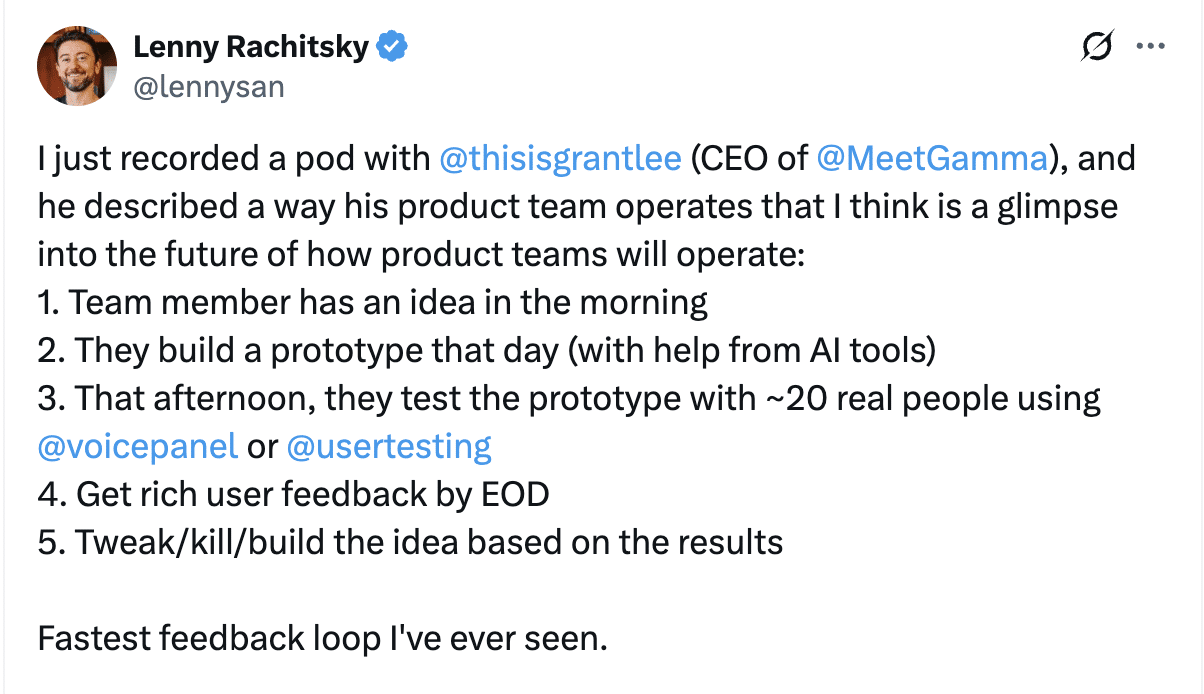Als langjährige SaaS-Investoren sind wir fasziniert davon, wie KI den Softwareentwicklungszyklus umgestaltet. Teams entwickeln und liefern Produkte in einem Tempo, das vor einem Jahr noch undenkbar war – und im Zentrum dieser Veränderung steht das Produktmanagement.
Die Ausführungsgeschwindigkeit war noch nie so hoch, aber die Kunst des guten Bauens wird in Echtzeit neu geschrieben. Anfang des Monats haben wir beim Future of Product -Dinner von Battery ein Dutzend Produktleiter zusammengebracht, um zu diskutieren, wie sich die Rolle des PM sowohl bei Startups als auch bei Unternehmen weiterentwickelt. Nachfolgend sind sieben Veränderungen aufgeführt, die sich gezeigt haben:
1. Von der „Writing First“- zur „Building First“-Produktkultur
Viele große etablierte Unternehmen versuchen, ihre traditionelle, auf PRDs und strukturierten Ritualen basierende „schreibintensive“ Kultur zu verlernen. Um mit der Geschwindigkeit eines Startups Schritt zu halten, verfolgen sie eine Kultur, bei der der Aufbau an erster Stelle steht und bei der gezeigt wird, nicht erzählt wird. Von PMs wird heute erwartet, dass sie mithilfe von Tools wie V0, Lovable und Cursor Prototypen erstellen, Ideen validieren und iterieren – und nicht nur Dokumente schreiben.

Grant Lee, CEO vonGamma, gewährte kürzlich bei Lenny‘s Podcast einenEinblick in die Arbeitsweise seines Produktteams – was früher wochenlange Planung erforderte, kann jetzt vor dem Mittagessen erledigt werden. Dieses Tempo verändert die Arbeitsweise von PMs grundlegend.
2. Engineering ist nicht länger der Engpass
Jahrelang war die technische Bandbreite der begrenzende Faktor für die Produktgeschwindigkeit. Mit KI-gestützten Codierungstools hat sich dieser Engpass verschoben und ein neuer ans Licht gebracht: Klarheit. Ingenieure können Funktionen jetzt schneller erstellen und ausliefern, als PMs planen können, und in einigen Fällen schneller, als Benutzer sie aufnehmen können.
Wie ein Produktleiter bemerkte, bitten die Kunden sie nun, die Einführung neuer Funktionen zu verlangsamen, da sie frustriert sind, weil sich die Benutzeroberfläche scheinbar jede Woche ändert. Das größte Risiko für Produktteams besteht heute nicht darin, zu langsam vorzugehen, sondern darin, sich schnell in die falsche Richtung zu bewegen.
3. Jeder ist ein Produktentwickler
Dylan Field, CEO von Figma, bemerkte kürzlich: „Wir sind alle Produktentwickler und einige von uns sind auf ihren jeweiligen Bereich spezialisiert.“ Durch die Überschneidung der Rollen lösen sich die traditionellen Grenzen zwischen Engineering, Produktdesign (EPD) auf. PMs entwerfen und erstellen Prototypen unabhängig voneinander; Designer denken gründlicher darüber nach, was und warum sie bauen; und Ingenieure beteiligen sich direkt an der Benutzererkennung und -validierung. Design ist in vielerlei Hinsicht zum Bindegewebe geworden, das Geschwindigkeit in Kohärenz übersetzt.
4. Die Produktstrategie geht über den Bau hinaus
Für KI-Startups ist es schwieriger denn je, sich aus der Masse der Gleichförmigkeit abzuheben. Da die Differenzierung immer schwieriger wird, werden PMs stärker in die Preisgestaltung, Verpackung und Positionierung einbezogen – Bereiche, die traditionell den Go-to-Market-Teams vorbehalten waren.
Aufgrund ihrer Nähe zum Kundennutzen, zur Gestaltung des Workflows und zu den Ergebnissen für die Benutzer verfügen PMs häufig über den besten Kontext, um zu entscheiden, wie ein Produkt bepreist werden sollte, wie der Wert kommuniziert werden sollte und wofür die Benutzer tatsächlich bezahlen werden. In vielen KI-nativen Unternehmen wie Unify* berichtet das Produktmarketing mittlerweile direkt an das Produkt – ein Zeichen dafür, wie eng Produktstrategie und -narrativ miteinander verflochten sind.
5. FDEs und Agent-PMs verwandeln KI in ROI
Eine der interessanteren Entwicklungen, die sich gezeigt haben, ist, wie Startups Unternehmen tatsächlich dabei helfen, mithilfe von KI aufzubauen .
In dieser KI-Welle ist jeder, vom Startup bis zum Großunternehmen, ein Early Adopter. Viele große Unternehmen haben KI-Kompetenzzentren eingerichtet, um Anwendungsfälle abzubilden und zu priorisieren, aber ihnen fehlt oft die technische Tiefe, um tatsächlich agentenbasierte Anwendungen zu erstellen und einzusetzen.
Diese Lücke hat zum Aufkommen der FDE- (Forward Deployed Engineer) und Agent-PM-Modelle geführt, bei denen Startups wie Ramp dedizierte Pods in Unternehmenskunden einbetten, um einen Anwendungsfall von der Definition über den Prototyp bis hin zur Produktion und zum ROI zu begleiten. Es handelt sich um einen serviceintensiven, aber ROI-orientierten Ansatz, der schnell greifbare Ergebnisse liefert. Mit der Zeit dürften sich diese Partnerschaften mit zunehmender Reife der Unternehmen zu stärker produktorientierten Selbstbedienungsmodellen entwickeln.
6. Neudefinition der Produkterfolgsmetriken für Agenten-Apps
Traditionelle Metriken wie DAU, MAU und Sitzungsdauer wurden für UI-basierte Produkte entwickelt, aber Agenten-Apps haben oft keine UI und zielen darauf ab, die Arbeit autonom zu erledigen. Der Erfolg verlagert sich hin zu ergebnisorientierten Kennzahlen wie Workflow-Abschlussraten oder Automatisierungsgenauigkeit. Kurz gesagt: Die „aufgewendete Zeit“ wird durch die „erledigte Arbeit“ ersetzt, was einen grundlegenden Wandel in der Definition von Produkterfolg und Benutzerwert bedeutet.
Ein Produktleiter stellte fest, dass nach der Einführung der KI-Agenten die Zahl der wöchentlich aktiven Benutzer insgesamt zurückgegangen sei, das Engagement unter den Power-Usern jedoch stark angestiegen sei. Bei diesen Power-Usern handelt es sich häufig um Administratoren, die sich häufig anmelden, um Konfigurationen zu optimieren, Agentenprotokolle zu prüfen und neue Agenten-Workflows zu erstellen.
7. KI-Evaluierungen werden Teil der PM-Disziplin
Da KI-Systeme von Natur aus nicht deterministisch sind, sind Bewertungen – einst eine technische Angelegenheit – heute ein zentraler Bestandteil der Rolle des PM. PMs entwerfen Bewertungsrahmen, die messen, wie gut Modelle oder Agenten im Hinblick auf Geschäftsziele abschneiden, und legen Schwellenwerte für Genauigkeit, Zuverlässigkeit und Qualität fest.
Diese Fähigkeit zur „KI-Evaluierung“ entwickelt sich zu einer neuen Säule der PM-Arbeit – einer, die Experimente, Analysen und Produktbeurteilungen kombiniert, um sicherzustellen, dass das Modellverhalten mit den beabsichtigten Ergebnissen übereinstimmt.
Die nächste Grenze des Produktmanagements
Da KI jeden Teil des Softwareentwicklungszyklus beschleunigt, verschmelzen die Rollen im Dienste eines gemeinsamen Ziels: der Entwicklung von Produkten, die für die Benutzer wirklich funktionieren. Die PMs, die in dieser neuen Ära erfolgreich sind, werden ihren Einfluss nicht an ausgelieferten Funktionen oder gelösten Problemen messen, sondern an der Klarheit, Kohärenz und dem Geschmack, den sie in das bringen, was gebaut wird – und was weggelassen wird.
Die in diesem Marktkommentar enthaltenen Informationen basieren ausschließlich auf den Meinungen von Sudheendra Chilappagari, Neeraj Agrawal und Jenny Kang und sollten nicht als Anlageberatung ausgelegt werden. Dieses Material dient zu Informationszwecken und stellt keine Rechts-, Steuer- oder Anlageberatung dar und darf auch nicht als solche oder als Angebot zum Verkauf oder Aufforderung zur Abgabe eines Angebots zum Kauf einer Beteiligung an einem von Battery Ventures oder einem anderen Unternehmen von Battery verwalteten Fonds oder Anlageinstrument verwendet werden. Die hier geäußerten Ansichten sind ausschließlich die der Autoren.
Die obigen Informationen können Prognosen oder andere zukunftsgerichtete Aussagen zu zukünftigen Ereignissen oder Erwartungen enthalten. Vorhersagen, Meinungen und andere Informationen, die in dieser Veröffentlichung diskutiert werden, können sich ständig und ohne Vorankündigung ändern und sind nach dem angegebenen Datum möglicherweise nicht mehr zutreffend. Battery Ventures übernimmt keine Verpflichtung und verpflichtet sich nicht, zukunftsgerichtete Aussagen zu aktualisieren.
* Bezeichnet eine Battery Portfolioinvestition. Eine vollständige Liste aller Battery Investitionen finden Sie unter klicken Sie hier.

Ein monatlicher Newsletter zum Austausch neuer Ideen, Erkenntnisse und Einführungen, um Unternehmer*innen beim Ausbau ihres Geschäfts zu helfen.








